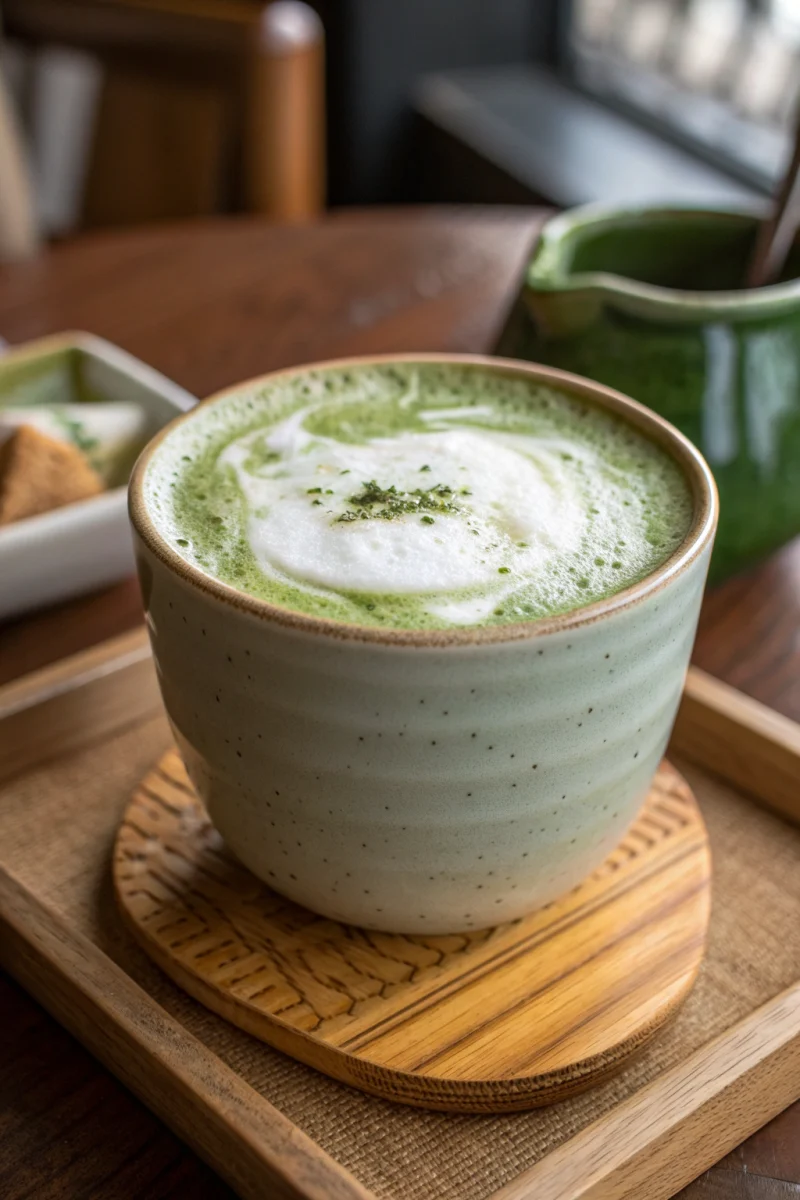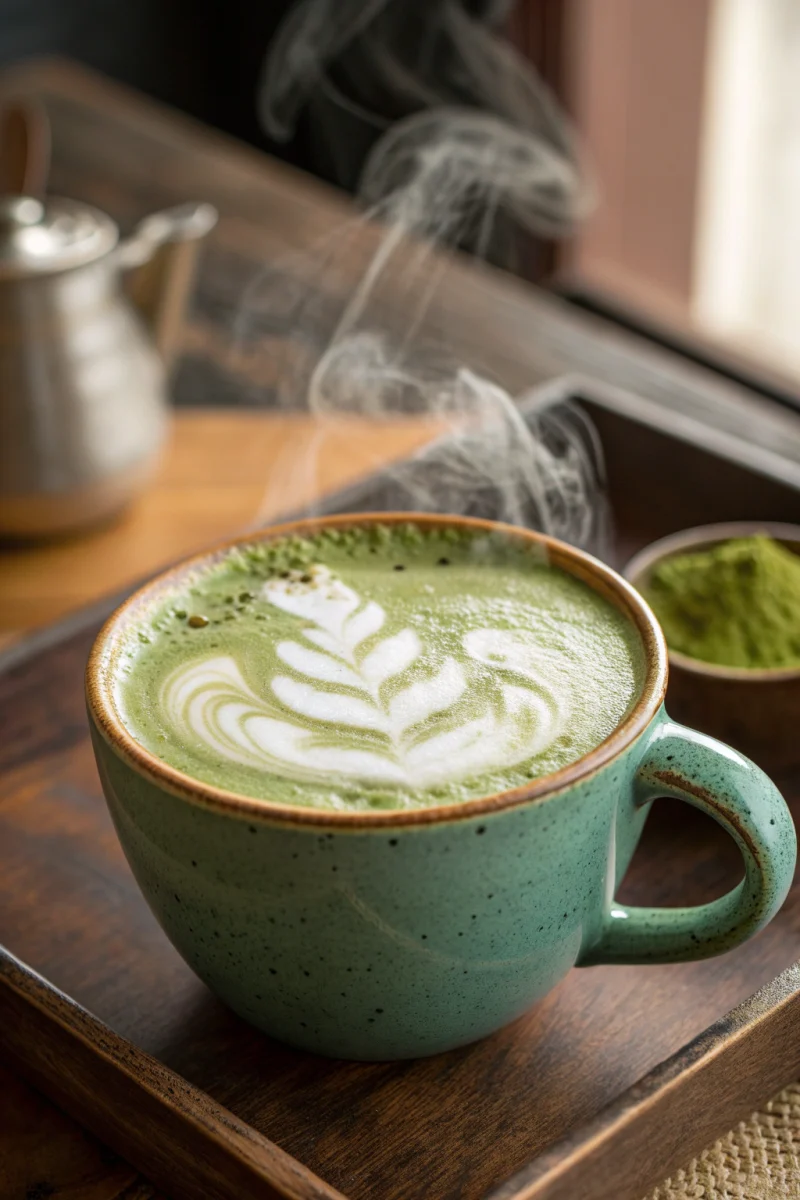Introduction
Cozy Hot Matcha Latte with Frothy Milk delivers café-level comfort in minutes—silky, bright, and gently sweet, perfect for a calm, energizing ritual at home.
Think making a delightful hot beverage from scratch is hard? Think again! This guide will show you how to craft a dreamy, Cozy Hot Matcha Latte with Frothy Milk right in your kitchen, debunking the myth that café-quality drinks require complex techniques or expensive equipment. Get ready to elevate your tea experience with simple steps and a few key ingredients.
Q: What does a Cozy Hot Matcha Latte with Frothy Milk taste like?
A: Creamy and velvety with grassy, slightly sweet notes of matcha and gentle vanilla—comforting without being heavy.
Q: Do I need special tools?
A: A bamboo whisk is ideal, but a small kitchen whisk or handheld frother works great, too.
Ingredients List

Gather these vibrant ingredients for your comforting matcha latte:
- Matcha Green Tea Powder: 1-2 teaspoons (culinary or ceremonial grade, depending on desired richness). Choose ceremonial grade for a smoother, less bitter taste in beverages.
- Hot Water: 1/4 cup (175°F/80°C). Avoid boiling water, as it can burn the matcha and make it bitter.
- Milk: 3/4 cup (dairy or non-dairy, such as almond, oat, or soy milk, warmed). Whole milk provides the creamiest froth, while oat milk offers a naturally sweet and silky texture.
- Sweetener (Optional): 1-2 teaspoons (honey, maple syrup, or agave nectar). Adjust to your preference for a perfectly balanced sweetness.
- Vanilla Extract (Optional): 1/4 teaspoon for an added layer of aroma.
Q: Ceremonial vs. culinary grade—what’s best for lattes?
A: Ceremonial is smoother and greener; culinary is bolder and budget-friendly—great if you add sweetener or flavors.
Q: Which milk froths best?
A: Whole dairy froths richly; oat milk (barista style) gives stable microfoam with a light sweetness.
Prep Time
- Prep time: 2 minutes
- Cook time: 3 minutes
- Total time: 5 minutes
This recipe is approximately 30% faster than brewing traditional tea and frothing milk separately.
Q: Can I make a batch for guests?
A: Yes—whisk a concentrated matcha base in a pitcher and steam/froth milk per cup.
Preparation Steps
Step 1: Prepare the Matcha
In a small bowl, combine the matcha powder and hot water. Use a bamboo whisk (chasen) to whisk vigorously in a W or M shape until a smooth, bright green paste forms with no lumps and a frothy layer on top.
- Tip: If you don’t have a bamboo whisk, a small kitchen whisk or even an electric frother can work, but a traditional whisk yields the best froth.
Step 2: Heat and Froth the Milk
Gently warm your milk on the stovetop over medium heat or in the microwave until it’s steamy but not boiling. If desired, use a milk frother or an immersion blender to create a rich, airy foam.
- Tip: For stovetop frothing without special equipment, vigorously whisk the warm milk by hand until bubbly.
Step 3: Combine and Sweeten
Pour the whisked matcha into your favorite mug. Add your desired sweetener and vanilla extract, if using, and stir to dissolve. Slowly pour the warm, frothed milk over the matcha, holding back the foam with a spoon initially, then spooning it on top.
- Tip: Experiment with different sweeteners to find your preferred flavor profile. A sprinkle of cinnamon or nutmeg makes a lovely garnish.
Q: Why not use boiling water?
A: Boiling water can scorch matcha, causing bitterness. Aim for ~175°F/80°C.
Q: My foam collapses—what happened?
A: Milk overheated or under-aerated. Keep it below a simmer and use steady circular motions.
Nutritional Information
Per serving (approximate, based on whole milk and honey):
- Calories: 120-180 kcal
- Protein: 5-8g
- Fats: 4-7g
- Carbohydrates: 12-20g
- Sodium: 60-100mg
- Fiber: 1-2g
Q: How much caffeine is in a Cozy Hot Matcha Latte with Frothy Milk?
A: Roughly 60–80 mg per cup if using 1–2 tsp matcha, but exact values vary by brand and grade.
Healthy Alternatives
- Dairy-Free: Opt for unsweetened almond, oat, or soy milk. Oat milk offers a creamy texture closest to dairy.
- Low-Sugar: Omit the sweetener entirely or use a natural, sugar-free alternative like stevia or monk fruit.
- Boosted Nutrition: Add a pinch of Ceylon cinnamon for anti-inflammatory benefits or a dash of collagen powder for extra protein.
- Vanilla-Free: If you prefer a pure matcha flavor, simply skip the vanilla extract.
Q: Can I use protein milk?
A: Yes—high-protein dairy or soy froths well and adds staying power.
Serving Suggestions
Serve your Cozy Hot Matcha Latte in a clear glass mug to showcase its beautiful layers of vibrant green and creamy white froth. Garnish with a light dusting of matcha powder, a pinch of cinnamon, or a small sprig of mint. A small, delicate cookie or a piece of dark chocolate pairs wonderfully with its earthy notes.
Q: What snacks pair well?
A: Dark chocolate, almond biscotti, or a slice of Cinnamon Swirl Quick Bread.
Common Mistakes to Avoid
- Using boiling water: This can scorch the matcha, leading to a bitter taste. Always use water around 175°F (80°C).
- Not whisking enough: Insufficient whisking results in a lumpy matcha paste and a less frothy texture. Ensure the matcha is fully dissolved and has a good foam.
- Over-sweetening: Matcha has a unique, delicate flavor. Start with a small amount of sweetener and add more gradually to avoid overpowering the tea.
- Using poor quality matcha: Low-grade matcha can taste gritty or overly bitter. Invest in a good quality culinary or ceremonial grade powder for the best experience.
Q: Why is my latte dull in color?
A: Older or low-quality matcha oxidizes and looks brownish—use a fresh, vibrant green powder.
Storage Tips
This drink is best enjoyed immediately. However, if you have any leftover frothed milk or prepared matcha, store them separately in airtight containers in the refrigerator for up to 24 hours. Reheat milk gently and re-froth before combining with whisked matcha. This recipe is not suitable for freezing.
Q: Can I refrigerate the matcha base?
A: Yes—keep the paste covered up to 24 hours; re-whisk before using.
Conclusion
Creating your own Cozy Hot Matcha Latte with Frothy Milk is a simple pleasure that brings a touch of calm and warmth to your day. This balanced beverage offers both a gentle energy boost and a moment of tranquility, proving that delicious, healthful treats are well within reach. Embrace the ritual, savor the flavor, and enjoy the satisfaction of making your own café-worthy drink.
FAQ
Q1: What’s the difference between culinary and ceremonial matcha?
A1: Ceremonial grade matcha is ground from younger, finer tea leaves, offering a smoother, less bitter taste, ideal for drinking on its own. Culinary grade is more robust and designed to be mixed with other ingredients in recipes.
Q2: Can I make this latte iced?
A2: Absolutely! Simply whisk the matcha with cold water, add sweetener, then pour over ice with cold milk. You can still froth the milk for an iced version too.
Q3: How do I get extra frothy milk without an electric frother?
A3: Heat your milk, then transfer it to a French press and pump the plunger rapidly until foamy. Alternatively, shake warm milk in a tightly sealed jar until frothy.
Q4: Is matcha healthy?
A4: Yes, matcha is packed with antioxidants, particularly catechins, and contains L-theanine, which promotes a calm alertness and can boost metabolism.
Q5: Can I prepare the matcha ahead of time?
A5: While best freshly whisked, you can prepare the matcha paste up to a few hours in advance and store it covered in the refrigerator. Re-whisk briefly before combining with milk.
Q6: What kind of cup is best for a matcha latte?
A6: A a wide-mouthed bowl or a cozy mug works wonderfully. For aesthetic appeal, use a clear glass to admire the color.
You Might Also Like
- Looking for another great morning pick-me-up? Try our Pumpkin Spice Latte Overnight Oats for a convenient and flavorful breakfast.
- If you enjoyed the flavor of matcha, you’ll love the refreshing twist of an Iced Dirty Matcha Latte with Espresso.
- Prefer a cold version? See our step-by-step Dirty Matcha Latte guide.
- For quick and satisfying meals, explore our collection of Quick 12 Easy Dinner Recipes.
- If you’re interested in broadening your tea knowledge, check out this guide on How to Make Matcha Lattes on Bon Appétit.
- Discover more ways to use matcha in your cooking and beverages with these creative ideas from Food Network’s Matcha Recipes.
Equipment & Tools (Barista Basics)
- Chawan (bowl): Wide enough for vigorous whisking without splashing.
- Chasen (bamboo whisk): Creates microfoam and breaks up clumps.
- Chashaku (scoop): Measures matcha consistently (about 1/2 tsp per scoop).
- Fine mesh sieve: Sift matcha for the smoothest texture.
- Handheld frother or French press: Excellent alternatives for milk foam.
- Thermometer: Optional, but helpful to keep water near 175°F/80°C.
Q: Do I really need a sieve?
A: Sifting eliminates clumps instantly and improves both taste and color.
Milk Options & Frothing Science
Milk proteins (especially whey) stabilize bubbles, while fats add body and creaminess. For dairy, whole milk produces the richest mouthfeel. For plant milks, oat (barista versions), soy, and pea milks develop stable microfoam with slightly different flavor profiles. Heat milk to “drinking hot” (140–150°F / 60–65°C) to protect proteins and avoid scalding.
- Oat milk: Naturally sweet; silky foam that holds latte art.
- Soy milk: Higher protein; can curdle if overheated—keep temps in range.
- Almond milk: Light body; foam dissipates faster—use a frother for best results.
Q: Why does my plant milk split?
A: Temperature shock or acidity. Warm both components and pour slowly while stirring.
Flavor Variations
- Vanilla Cardamom: 1/8 tsp ground cardamom + 1/4 tsp vanilla.
- Maple Spice: 1–2 tsp pure maple syrup + pinch of cinnamon.
- Honey Ginger: 1 tsp honey + 1–2 tsp freshly grated ginger tea (strained).
- Dirty Matcha: Add 1–2 oz hot espresso (see our iced version for ratios).
- Cocoa Twist: 1 tsp unsweetened cocoa whisked with matcha for a “green mocha.”
Q: What’s the best sweetener?
A: Maple for warmth, honey for floral notes, simple syrup for cleaner sweetness.
Make-Ahead & Batch Prep
For a brunch crowd, scale up by whisking a concentrated matcha base (matcha + hot water) in a heatproof pitcher. Keep it warm in a hot-water bath. Froth milk per cup to ensure fresh foam. Leftover base keeps 24 hours refrigerated; re-whisk before serving.
Q: Can I prep sweetened milk ahead?
A: Yes—combine milk and sweetener; warm and froth just before serving.
Caffeine & Nutrition Notes
Matcha provides a steadier lift than coffee thanks to L-theanine, which tempers caffeine’s edge. One teaspoon of matcha typically contains a moderate caffeine level; adjust to your needs. If you’re sensitive, start with 1/2 teaspoon or opt for a smaller cup.
Q: Afternoon friendly?
A: Many people tolerate matcha later in the day, but try a smaller serving after noon.
Sourcing & Quality
Look for vibrant, spring-green matcha from reputable producers. Airtight, opaque packaging is essential to prevent light and oxygen from dulling flavor and color. Store your tin in a cool, dark cupboard and use within a few months for peak aroma.
Q: Does price equal quality?
A: Not always, but very cheap matcha is often dull and bitter. Compare color, aroma, and origin.
Barista-Style Latte Art (Optional)
- Whisk a slightly thinner matcha base (add 1–2 tbsp extra hot water).
- Froth milk to silky microfoam—no large bubbles.
- Swirl the cup, then pour from 2–3 inches, raising and lowering to form a dot, heart, or leaf.
Q: Can I do art with plant milk?
A: Yes—oat barista milks are the most forgiving for simple shapes.
Additional Helpful Resources
- Technique deep-dive: Bon Appétit—How to Make Matcha Lattes.
- Ideas round-up: Food Network—Matcha Recipes.
- Flavor science & tips:

Food lover & recipe creator sharing simple, protein-rich recipes for busy lives.

